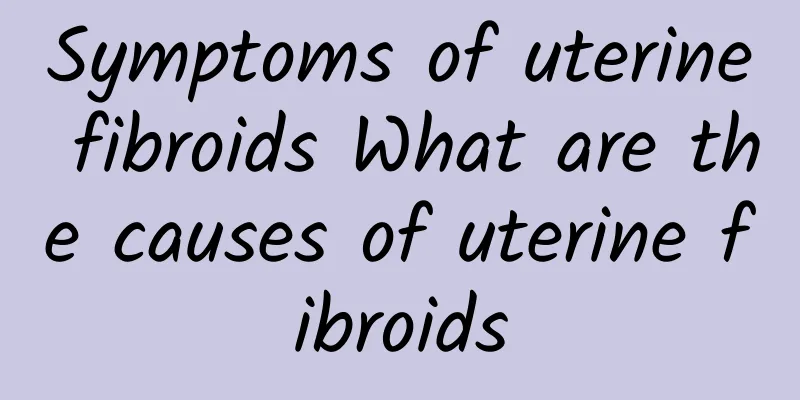Symptoms of uterine fibroids What are the causes of uterine fibroids

|
Uterine fibroids are common genital tumors in women, and the common symptoms of uterine fibroids are also a topic of concern for most women. So what are the symptoms of uterine fibroid bleeding? Generally speaking, the symptoms of uterine fibroid bleeding are mainly contact bleeding caused by intramural fibroids and submucosal fibroids. Uterine fibroids are the most common benign tumors in the female reproductive system, mostly occurring between the ages of 35 and 50. According to statistics, about 20% of women over the age of 35 have uterine fibroids, but most patients do not discover them because the fibroids are small and asymptomatic. Clinically, the incidence of fibroids is only between 4% and 11%. Experts point out that the cause of uterine fibroids is still unclear, and current research mainly relates to excessive estrogen levels in the body and long-term estrogen stimulation. Generally speaking, uterine fibroids mainly manifest in the following aspects: 1. Increased leucorrhea Due to the enlargement of the uterine cavity and the area of the endometrium, the secretion of the endometrial glands increases. Coupled with the growth of uterine fibroids, pelvic vascular congestion leads to increased leucorrhea. Nearly half of patients with uterine fibroids have symptoms of increased leucorrhea. 2. Menstrual changes Menstrual changes are the most common symptoms of uterine fibroids, which are manifested as increased menstrual volume, longer menstrual cycles, shorter menstrual cycles, and frequent menstruation. The menstrual cycle can be shortened to 15-20 days, menstrual bleeding exceeds 7 or 8 days, and the menstrual volume increases significantly, and there may be blood clots. Submucosal uterine fibroids can also cause irregular vaginal bleeding and menstruation that is not clean. 3. Abdominal mass Some women discover they have uterine fibroids because they accidentally touch a lump in their lower abdomen. These patients usually have no symptoms, and the lump is more noticeable in the morning when they hold their urine. 4. Compression symptoms Because the uterus is located between the bladder muscle and the rectum, when uterine fibroids grow relatively large, they can press forward on the bladder, causing urgency and increased urination. Sometimes, due to the compression of the bladder by the fibroids, urine cannot be cleaned and is retained in the bladder, causing inflammation and infection. The enlarged uterus can compress the rectum, and the patient will experience difficulty in defecation and constipation. 5. Abdominal pain, back pain, feeling of falling If there are no complications with uterine fibroids, there will be no abdominal pain. When the pedicle of subserosal uterine fibroids is torsion, acute abdominal pain may occur. When the uterine fibroids are large, they will compress and pull the blood vessels, nerves and connective tissues in the pelvic cavity, and cause blood accumulation in the pelvic cavity, resulting in lower abdominal swelling and dice pain. Fatigue or menstruation may be aggravated by symptoms of pelvic congestion. |
>>: What are the symptoms of secondary uterine fibroids? How to use medicine for uterine fibroids
Recommend
What are the clinical symptoms of miscarriage?
Young boys, young girls, and ignorant girls accid...
What are the diseases similar to vulvar leukoplakia?
There are many diseases that are misdiagnosed bec...
What are the better care methods for bacterial vaginosis?
Many diseases need care to get better quickly, es...
What are the ways for women to prevent pelvic peritonitis?
Pelvic peritonitis worries many women. The format...
What are the sequelae of severe adnexitis?
Severe adnexitis may lead to infertility, chronic...
What causes stomach pain during menstruation?
Stomach pain during menstruation is caused by eat...
Analysis of common causes of ectopic pregnancy
According to recent medical data, the incidence o...
Pay attention to ovarian cysts and analyze the two major hazards
Ovarian cysts are a serious disease that develops...
Can I have an abortion at six months old? See what the doctor says
If the fetus is not well developed, an abortion i...
What is the effect of menstruation on uterine fibroids? Is menstruation good or bad for uterine fibroids?
What effect does menstruation have on uterine fib...
Do you know what are the symptoms of ovarian cysts?
As more and more people are suffering from ovaria...
Do you know the cause of uterine fibroids?
Uterine fibroids are a very harmful gynecological...
What should I do if bleeding suddenly appears a few days after an abortion?
What should I do if bleeding suddenly appears a f...
A must-have for winter weight loss! Chrysanthemum officinale protects the liver and promotes detoxification
It’s the peak season for hotpot again. For office...
Exercise and diet control, but still can’t lose body fat? You may have overlooked these two things
"Endocrine" and "stress management...









